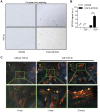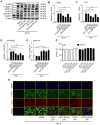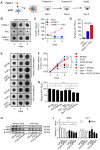FGF2 engineered SPIONs attenuate tumor stroma and potentiate the effect of chemotherapy in 3D heterospheroidal model of pancreatic tumor
- PMID: 31911892
- PMCID: PMC6940204
- DOI: 10.7150/ntno.38092
FGF2 engineered SPIONs attenuate tumor stroma and potentiate the effect of chemotherapy in 3D heterospheroidal model of pancreatic tumor
Abstract
Pancreatic ductal adenocarcinoma (PDAC), characterized with abundant tumor stroma, is a highly malignant tumor with poor prognosis. The tumor stroma largely consists of cancer-associated fibroblasts (CAFs) and extracellular matrix (ECM), and is known to promote tumor growth and progression as well as acts as a barrier to chemotherapy. Inhibition of tumor stroma is highly crucial to induce the effect of chemotherapy. In this study, we delivered fibroblast growth factor 2 (FGF2) to human pancreatic stellate cells (hPSCs), the precursors of CAFs, using superparamagnetic iron oxide nanoparticles (SPIONs). FGF2 was covalently conjugated to functionalized PEGylated dextran-coated SPIONs. FGF2-SPIONs significantly reduced TGF-β induced hPSCs differentiation (α-SMA and collagen-1 expression) by inhibiting pSmad2/3 signaling and inducing ERK1/2 activity, as shown with western blot analysis. Then, we established a stroma-rich self-assembling 3D heterospheroid model by co-culturing PANC-1 and hPSCs in 3D environment. We found that FGF2-SPIONs treatment alone inhibited the tumor stroma-induced spheroid growth. In addition, they also potentiated the effect of gemcitabine, as shown by measuring the spheroid size and ATP content. These effects were attributed to the reduced expression of the hPSC activation and differentiation marker, α-SMA. Furthermore, to demonstrate an application of SPIONs, we applied an external magnetic field to spheroids while incubated with FGF2-SPIONs. This resulted in an enhanced effect of gemcitabine in our 3D model. In conclusion, this study presents a novel approach to target FGF2 to tumor stroma using SPIONs and thereby enhancing the effect of gemcitabine as demonstrated in the complex 3D tumor spheroid model.
Keywords: cancer-associated fibroblasts; fibroblast growth factor 2; pancreatic cancer; pancreatic stellate cells; superparamagnetic iron oxide nanoparticles.
© The author(s).
Conflict of interest statement
Competing Interests: The authors have declared that no competing interest exists.
Figures







Similar articles
-
Nano-targeted relaxin impairs fibrosis and tumor growth in pancreatic cancer and improves the efficacy of gemcitabine in vivo.J Control Release. 2018 Nov 28;290:1-10. doi: 10.1016/j.jconrel.2018.09.031. Epub 2018 Oct 2. J Control Release. 2018. PMID: 30287265
-
Ferroptosis- and stemness inhibition-mediated therapeutic potency of ferrous oxide nanoparticles-diethyldithiocarbamate using a co-spheroid 3D model of pancreatic cancer.J Gastroenterol. 2025 May;60(5):641-657. doi: 10.1007/s00535-025-02213-3. Epub 2025 Jan 31. J Gastroenterol. 2025. PMID: 39888413 Free PMC article.
-
The Crosstalk Analysis between mPSCs and Panc1 Cells Identifies CCN1 as a Positive Regulator of Gemcitabine Sensitivity in Pancreatic Cancer Cells.Int J Mol Sci. 2024 Aug 29;25(17):9369. doi: 10.3390/ijms25179369. Int J Mol Sci. 2024. PMID: 39273316 Free PMC article.
-
Opportunities and delusions regarding drug delivery targeting pancreatic cancer-associated fibroblasts.Adv Drug Deliv Rev. 2021 May;172:37-51. doi: 10.1016/j.addr.2021.02.012. Epub 2021 Mar 8. Adv Drug Deliv Rev. 2021. PMID: 33705881 Review.
-
Breaking Down Barriers in Drug Delivery by Stromal Remodeling Approaches in Pancreatic Cancer.Mol Pharm. 2024 Aug 5;21(8):3764-3776. doi: 10.1021/acs.molpharmaceut.4c00329. Epub 2024 Jul 24. Mol Pharm. 2024. PMID: 39049481 Review.
Cited by
-
Novel 3D µtissues Mimicking the Fibrotic Stroma in Pancreatic Cancer to Study Cellular Interactions and Stroma-Modulating Therapeutics.Cancers (Basel). 2021 Oct 6;13(19):5006. doi: 10.3390/cancers13195006. Cancers (Basel). 2021. PMID: 34638490 Free PMC article.
-
The Application of Nanoparticles Targeting Cancer-Associated Fibroblasts.Int J Nanomedicine. 2024 Apr 8;19:3333-3365. doi: 10.2147/IJN.S447350. eCollection 2024. Int J Nanomedicine. 2024. PMID: 38617796 Free PMC article. Review.
-
Nanomedicine in Pancreatic Cancer: Current Status and Future Opportunities for Overcoming Therapy Resistance.Cancers (Basel). 2021 Dec 7;13(24):6175. doi: 10.3390/cancers13246175. Cancers (Basel). 2021. PMID: 34944794 Free PMC article. Review.
-
DNA Nanostructures and DNA-Functionalized Nanoparticles for Cancer Theranostics.Adv Sci (Weinh). 2020 Oct 15;7(23):2001669. doi: 10.1002/advs.202001669. eCollection 2020 Dec. Adv Sci (Weinh). 2020. PMID: 33304747 Free PMC article. Review.
-
MicroRNA-203-3p inhibits the proliferation, invasion and migration of pancreatic cancer cells by downregulating fibroblast growth factor 2.Oncol Lett. 2021 Aug;22(2):626. doi: 10.3892/ol.2021.12887. Epub 2021 Jun 30. Oncol Lett. 2021. PMID: 34267818 Free PMC article.
References
-
- Siegel RL, Miller KD, Jemal A. Cancer statistics, 2018. CA Cancer J Clin. 2018;68:7–30. - PubMed
-
- Bliss LA, Witkowski ER, Yang CJ, Tseng JF. Outcomes in operative management of pancreatic cancer. J Surg Oncol. 2014;110:592–8. - PubMed
-
- Ryan DP, Hong TS, Bardeesy N. Pancreatic adenocarcinoma. N Engl J Med. 2014;371:1039–49. - PubMed
-
- Conroy T, Desseigne F, Ychou M, Bouché O, Guimbaud R, Bécouarn Y. et al. Folforinox versus gemcitabine for metastatic pancreatic cancer. N Engl J Med. 2011;364:1817–25. - PubMed
Publication types
MeSH terms
Substances
LinkOut - more resources
Full Text Sources
Medical
Miscellaneous

